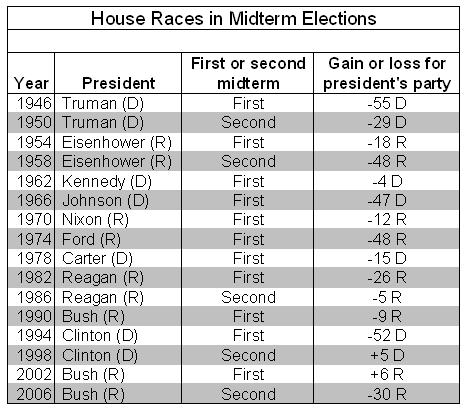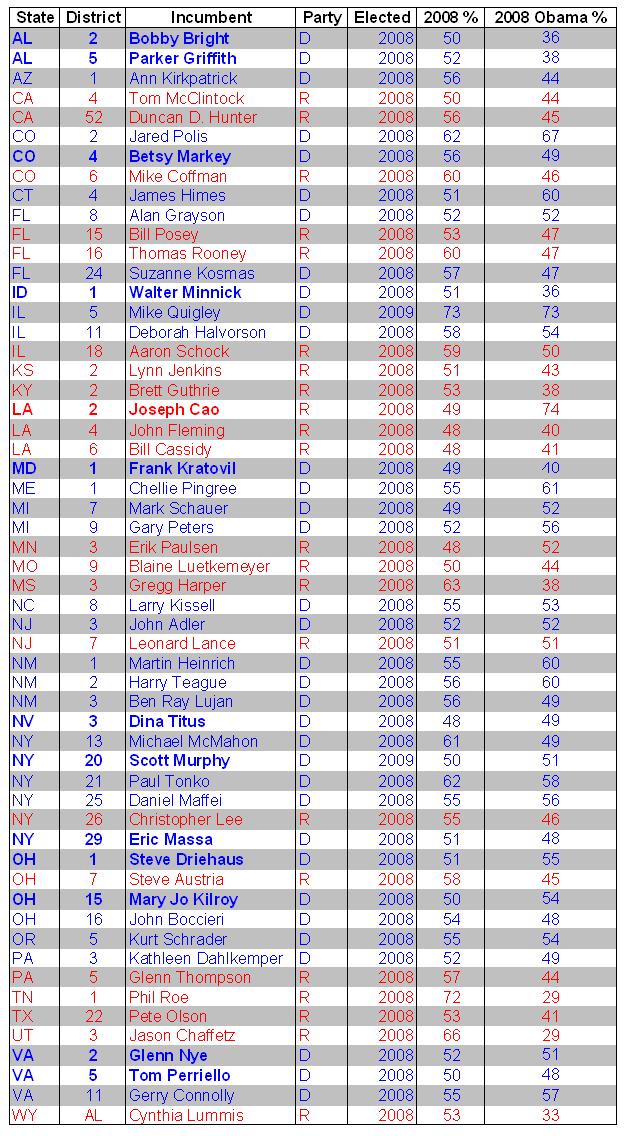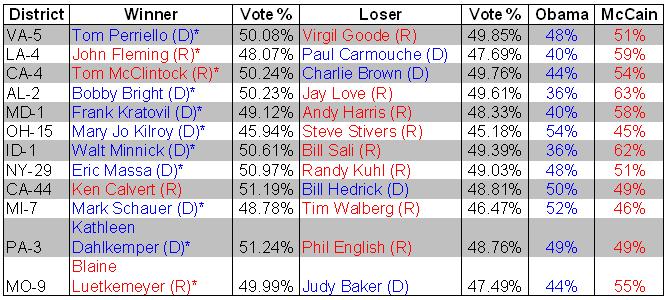Hot House 2010
A Commentary By Larry J. Sabato, Issac Wood and Paul Wiley
We are barely into the two-year term for the current House of Representatives, but you can be sure that the 2010 contests have already begun. That is especially true for members of the House who are in two-party competitive districts. For them, it is a permanent campaign.
Relatively few incumbents have challengers out-and-about already. So unlike our recent profiles of 2010 Senate races and Governorship battles, we will be focusing more on the districts likely to see good match-ups.
2010 is a midterm election, of course, and traditionally, voters use elections at the midpoint of a president's term to send him a message--sometimes of approval, usually of disapproval. The degree of disapproval varies widely from election to election. In Republican President Benjamin Harrison's one midterm election (1890), the electorate gave Democrats an additional 75 seats, so dissatisfied were they with Harrison's stewardship. Former President Grover Cleveland (D), who had lost a close election to Harrison in 1888, roared back to defeat his nemesis in 1892. But what goes around, comes around. The economic Panic of '93 produced an electoral disaster for Democrats in the midterm year of 1894, with Cleveland's party losing 116 seats. Never before or since has a governing party seen such a collapse of support in a single House election.
To simplify our task here, let's take a look only at the post-World War II midterm House elections--though, generally speaking, many of the same trends were observed throughout American history.
Just a glance down the table suggests that the president's party regularly loses seats in midterm elections. Since the end of World War II, that pattern has prevailed in 14 of 16 midterms. This only makes sense. Governing is hard and presidents make enemies. Inevitably, they alienate part of their base over time and infuriate the opposition with some decisions. Interestingly, the two midterm exceptions were for recent presidents. Public unhappiness with the GOP effort to impeach President Clinton produced a 5 seat net gain for Democrats in 1998, while public support for President Bush in the wake of the 9/11 terrorist attacks gave the GOP an extra 6 seats in 2002. In the 20th century only Franklin D. Roosevelt had achieved a similar feat, with Democrats gaining 9 House seats in 1934 as a display of the electorate's solidarity with FDR's New Deal.
Another pattern is also apparent in the table. A president's first midterm tends to be kinder than his second, held in the sixth year. Again, this is human nature. Presidents say, "I just got in, give my program a chance to work," in the first midterm. But after six years, the voters are unlikely to be sympathetic to a president who has already served two-thirds of his permitted tenure. Ike in 1954, JFK in 1962, Carter in 1978, and Bush Sr. in 1990 got off relatively easy in the first midterm. Yet there is hell to pay with the "sixth year itch." Ike in 1958, LBJ in 1966 (the sixth year of the Kennedy-Johnson Democratic presidency), Gerald Ford in 1974 (the sixth year of the Nixon-Ford Republican presidency), and George W. Bush in 2006 all had to scratch a nasty itch in their second midterm.
There are plenty of exceptions to these trends. It is difficult to make much of Truman's losses in 1946 and 1950 since he was at the tail end of a twenty-year-long Democratic presidency. A severe recession in 1982 produced a sharp rebuke for Ronald Reagan in his first midterm election, but his second midterm saw a tiny GOP loss in the House when times were better. Bill Clinton also switched midterm effects; he had his sixth year itch in the second year, losing 52 seats, but gained a few in his next midterm.
It's already clear that the shape of the economy will mold President Obama's first midterm. How much of a recovery will we have seen? Will Americans be hopeful or pessimistic about the future? And other factors will play some role, too. What will the wars in Iraq and Afghanistan be like in 2010? Will terrorists have hit the homeland again? Will the Obama administration suffer through a series of political and governmental scandals?
The answers to all of these questions are unknown so early in Obama's term. If economically, everything's coming up roses in 2010, perhaps Obama could match the feat of FDR and George W. Bush, and pick up House seats in 2012. If the economy is still a disaster area in two years, perhaps Obama will follow the Reagan and Clinton model, and lose a large number of House berths in the first midterm.
So far, the Obama Administration and congressional Democrats are off to a strong start, and the national GOP--especially the congressional Republicans--couldn't be weaker. It is certainly possible that 2010 will be added to the short list of good midterm years for the incumbent party, with almost all incumbent Democrats being reelected and non-incumbent Democrats gaining enough open seats or GOP seats to score an overall gain. However, this far away from Election Day, that is not the best bet.
History instead suggests that the overall odds favor Republican gains in the House in 2010, but relatively modest gains. After all, Democrats now hold 257 House seats, 39 seats more than the minimum needed to control the House. Only Truman in 1946 and Clinton in 1994 yielded more than 39 seats to the opposition party in their first midterm election.
So which seats will the Crystal Ball watch most closely as we approach 2010? First, let's keep an eye on all the freshmen.
Note that out of 56 total freshmen, we currently believe that only 13 are easily targeted (indicated in bold). Some of the targeted, maybe most, will survive to see their sophomore term. A few of the other safer freshmen may get into trouble for one reason or another, and be added to the list.
Another way to look at the districts is to see which ones had a divide in 2008, that is, which House districts voted for a Democrat for president and simultaneously for a GOP House candidate (34 districts), or the reverse--Republican for president and Democratic for the House (49 districts). For a comprehensive list of all 83 of these "divided districts" click here. These districts are schizophrenic in political orientation and subject to cross-pressures. Under the right set of circumstances, they can flip parties for the House in a midterm election.
One last group of potential targets consists of those incumbents who won by the narrowest of margins in 2008. The top dozen squeakers, shown below, will be among the first districts each party's operatives will scrutinize in an attempt to reverse the narrow 2008 results. Those incumbents marked by asterisks are serving as freshmen members of Congress and therefore have an added level of vulnerability. The most dangerous combination of circumstances, of course, is a combination of a slim victory in 2008 in a district carried by the opposing party's presidential nominee.
If your member of Congress has not been on one of our lists so far, then he or she is probably safe for reelection in 2010.
We cannot stress enough how preliminary this analysis is. Some entrenched incumbents will retire, opening up their districts in certain cases for party turnover. Scandals will envelop other supposedly secure incumbents, leading to successful primary or general election upsets. Outstanding, well-funded challengers will be recruited in some districts not seen as vulnerable in this first look-see. None of us can imagine all the twists and turns at the national, macroscopic level of politics or the local, microscopic level. The Crystal Ball will ride the currents with you all the way to November 2010--a mere 537 days from now.
Larry J. Sabato is the director of the Center for Politics at the University of Virginia.
See Other Commentary by Larry Sabato
See Other Political Commentary
Rasmussen Reports is a media company specializing in the collection, publication and distribution of public opinion information.
We conduct public opinion polls on a variety of topics to inform our audience on events in the news and other topics of interest. To ensure editorial control and independence, we pay for the polls ourselves and generate revenue through the sale of subscriptions, sponsorships, and advertising. Nightly polling on politics, business and lifestyle topics provides the content to update the Rasmussen Reports web site many times each day. If it's in the news, it's in our polls. Additionally, the data drives a daily update newsletter and various media outlets across the country.
Some information, including the Rasmussen Reports daily Presidential Tracking Poll and commentaries are available for free to the general public. Subscriptions are available for $4.95 a month or 34.95 a year that provide subscribers with exclusive access to more than 20 stories per week on upcoming elections, consumer confidence, and issues that affect us all. For those who are really into the numbers, Platinum Members can review demographic crosstabs and a full history of our data.
To learn more about our methodology, click here.



